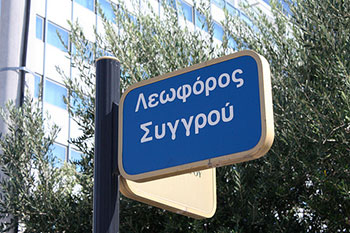
Source: Its all greek to me, dave patten, Flickr
In the romantic comedy My Big Fat Greek Wedding, the father Gus Portokalos claims that every ailment can be cured by Windex, and every word can be understood by knowing Greek. He brags, “Give me a word, any word, and I will show you that the root is Greek.” Knowing Greek roots helps you understand many words like thermometer, claustrophobia, and chronological, as you will discover in this lesson, but it doesn’t give you the key to every word in the English language. Watch this video that shows Mr. Portokalos trying to explain how the word kimono is derived from Greek.
Source: My Big fat greek wedding - Give me any word, and I show you how the root is greek..., rulfoq, YouTube
When Mr. Portokalos meets the Millers, he tries to convince them that their name also comes from a Greek word, instead of a Middle English word for one who grinds grain into flour, as they had always thought. Here’s what Mr. Portokalos says:
You know, the root of the word Miller is a Greek word. Miller comes from the Greek word “milo,” which is mean “apple,” so there you go. As many of you know, our name, Portokalos, is come from the Greek word “portokali,” which mean “orange.” So, okay? Here tonight, we have, ah, apple and orange. We all different, but in the end, we all fruit.
Despite Mr. Portokalos’ imaginative attempts to trace every word back to its Greek origin, learning Greek word parts is not a foolproof approach to learning new words, but he does make a good point. Greek and Latin roots form word families. If you know one word in the family, you can infer the meaning of many more words. Circum- is a word part that means “around.” The circumference is the distance around a geometric shape. Ferdinand Magellan was the first explorer to circumnavigate the globe. So if Mr. Portokalos circumlocutes, you can infer that he must be talking “around” a word.

Source: Latín en las paredes, mmarftrejo, Flickr
Knowing Greek and Latin word parts can be an effective shortcut to learning a lot of words. By learning one word part, you can potentially learn multiple words and increase your vocabulary. Over half of all the multisyllabic words you’ll encounter in the upper grades contain a Greek or Latin word part, so learning those word parts will be well worth the time you invest.
You will learn about three kinds of word parts. A root is the stem or base of a word. An affix is a part of the word that can be attached to the beginning or ending to give a word more meaning. In this lesson, you will learn about two kinds of affixes—prefix and suffix. Prefixes are affixed, or attached, before a root or base word, and suffixes are affixed to the end of a word. You’ll learn how all three word parts are keys to unlocking the meanings of unfamiliar words. At the end of the lesson, you’ll read an essay and apply what you’ve learned about roots and affixes to determine the meanings of some of the words.